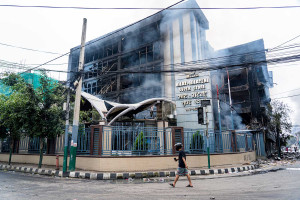Money
Bad weather forces carriers to cancel one-third of flights
Domestic carriers were forced to cancel one-third of their scheduled flights last year because of heavy rain, high winds or blinding fog
Sangam Prasain
Airlines cancelled 12,675 flights, most of them due to bad weather conditions, which led to losses in the millions. Of the 39,128 scheduled flights, only 26,453 took off.
Airlines said that last year was one of their worst years as that was also when the European Commission put Nepal in the European Union air safety list.
Buddha Air cancelled one-fourth of its flights. It cancelled 4,750 of its 12,110 scheduled flights. Its close competitor Yeti Airlines conducted 9,092 flights, while it cancelled 3,296 flights. Yeti’s subsidiary Tara Air cancelled 2,453 flights and operated 3,501 flights last year.
Likewise, Simrik Airlines operated 2,439 flights and cancelled 1,338 flights. Nepal Airlines and Sita Air had grounded 515 and 322 flights respectively last year, according to the statistics.
Operators estimate that cancellation of a long-haul flight causes a loss of Rs 300,000 to Rs 400,000 depending on the number of passengers. On an average, a 19-seater aircraft earns $ 3,000 from a round trip on the Kathmandu-Lukla sector, the most lucrative flight for domestic carriers.
“The period December to February is a bad time for all domestic carriers as they are forced to make a huge number of cancellations and delays due to adverse weather conditions,” said Rupesh Joshi, senior executive of Buddha Air.
“Obviously, last winter was the most painful for airlines,” he said, adding that Biratnagar and Dhangadhi airports were closed for 10 consecutive days due to a cold wave.
According to him, a 50 percent flight cancellation per month means a loss of around Rs 80 million for Buddha Air. “In the Tarai, airport visibility normally drops to zero due to cold waves, and there is nothing that can be done about such climatic behaviour.”
Airlines said that flights were cancelled in the monsoon too. Sometimes, a scheduled flight will not take off if there aren’t enough passengers.
Tri Ratna Manandhar, former director general of the Civil Aviation Authority of Nepal (Caan), said that flight cancellations and delays were not a new problem in Nepal given the climatic variability and difficult terrain.
He added that installing advanced navigation systems at airports could reduce such cancellations, but that was not commercially viable as the equipment is expensive and difficult to maintain. “If instrumental landing system (ILS) is installed in airports, aircraft can land even in zero visibility.”
ILS is a ground-based instrument approach system that provides precise guidance to aircraft during its approach and landing using a combination of radio signals and, in many cases, high-intensity lighting arrays to enable a safe landing in reduced visibility due to fog, rain or blowing snow.
Manandhar said that a combination of factors like EC’s black listing of Nepali carriers, high airfares and weather problems had affected profits of domestic airlines.
Domestic air passenger movement dropped 7.76 percent in the first three months of 2014. The 14 domestic airlines, including helicopter operator, flew 332,853 passengers in the first quarter, 28,017 less compared to the same period a year ago, said Tribhuvan International Airport (TIA).
TIA’s stats show that there were 90,875 flyers on 4,116 flights in January. Occupancy gradually increased to 104,703 on 4,367 flights in February. Flight movement jumped to 6,212 in March with a total of 137,275 passengers.




 16.12°C Kathmandu
16.12°C Kathmandu













%20(1).jpg&w=300&height=200)
